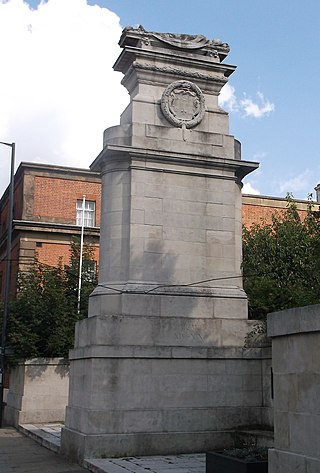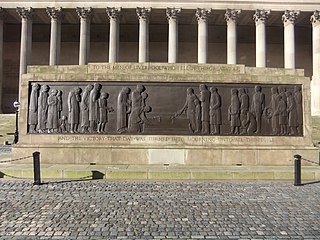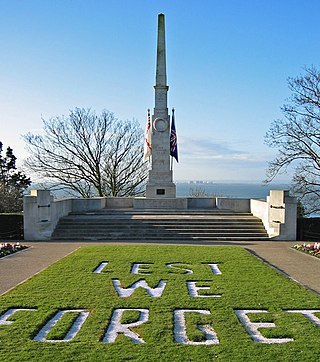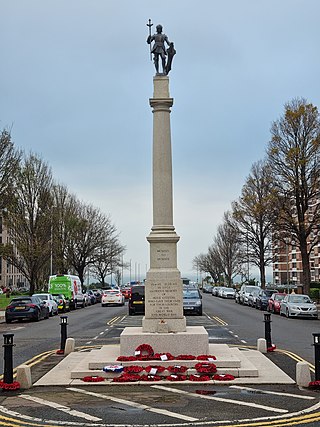
The Royal Artillery Memorial is a First World War memorial located on Hyde Park Corner in London, England. Designed by Charles Sargeant Jagger, with architectural work by Lionel Pearson, and unveiled in 1925, the memorial commemorates the 49,076 soldiers from the Royal Artillery killed in the First World War. The static nature of the conflict, particularly on the Western Front, meant that artillery played a major role in the war, though physical reminders of the fighting were often avoided in the years after the war. The Royal Artillery War Commemoration Fund (RAWCF) was formed in 1918 to preside over the regiment's commemorations, aware of some dissatisfaction with memorials to previous wars. The RAWCF approached several eminent architects but its insistence on a visual representation of artillery meant that none was able to produce a satisfactory design. Thus they approached Jagger, himself an ex-soldier who had been wounded in the war. Jagger produced a design which was accepted in 1922, though he modified it several times before construction.

Manchester Cenotaph is a war memorial in St Peter's Square, Manchester, England. Manchester was late in commissioning a First World War memorial compared with most British towns and cities; the city council did not convene a war memorial committee until 1922. The committee quickly achieved its target of raising £10,000 but finding a suitable location for the monument proved controversial. The preferred site in Albert Square would have required the removal and relocation of other statues and monuments, and was opposed by the city's artistic bodies. The next choice was Piccadilly Gardens, an area already identified for a possible art gallery and library; but in the interests of speedier delivery, the memorial committee settled on St Peter's Square. The area within the square had been had been purchased by the City Council in 1906, having been the site of the former St Peter's Church; whose sealed burial crypts remained with burials untouched and marked above ground by a memorial stone cross. Negotiations to remove these stalled so the construction of the cenotaph proceeded with the cross and burials in situ.

Rochdale Cenotaph is a First World War memorial on the Esplanade in Rochdale, Greater Manchester, in the north west of England. Designed by Sir Edwin Lutyens, it is one of seven memorials in England based on his Cenotaph in London and one of his more ambitious designs. The memorial was unveiled in 1922 and consists of a raised platform bearing Lutyens' characteristic Stone of Remembrance next to a 10-metre (33 ft) pylon topped by an effigy of a recumbent soldier. A set of painted stone flags surrounds the pylon.

The Midland Railway War Memorial is a First World War memorial in Derby in the East Midlands of England. It was designed by Sir Edwin Lutyens and unveiled in 1921. The memorial commemorates employees of the Midland Railway who died while serving in the armed forces during the First World War. The Midland was one of the largest railway companies in Britain in the early 20th century, and the largest employer in Derby, where it had its headquarters. Around a third of the company's workforce, some 23,000 men, left to fight, of whom 2,833 were killed.

Liverpool Cenotaph stands on St George's Plateau, to the east of St George's Hall in Liverpool, England. It was erected as a memorial to those who had fallen in the First World War. The dates of the Second World War were subsequently added. The cenotaph consists of a rectangular block of stone on a stone platform, with bronze, low-relief sculptures on the sides depicting marching troops and mourners. It was designed by Lionel Budden, with carving by Herbert Tyson Smith. Initially designated as a Grade II listed building, its status was raised to Grade I in 2013.

Macclesfield Cenotaph is a World War I memorial in Park Green, Macclesfield, Cheshire, England. It was unveiled in 1921, and consists of a stone pillar and pedestal and three bronze statues. One statue is that of a mourning female, and the others comprise Britannia laying a wreath over a soldier who had died from gassing, an unusual subject for a war memorial at the time. The memorial is recorded in the National Heritage List for England as a designated Grade II* listed building.

Birkenhead War Memorial, or Birkenhead Cenotaph, stands in Hamilton Square, Birkenhead, Merseyside, England, opposite the Town Hall. It consists of a cenotaph in Portland stone with carved figures and panels in Westmorland stone. The memorial was designed by Lionel Budden, and the sculptor was H. Tyson Smith. It was unveiled in 1925 by Lieutenant-General Sir Richard H. K. Butler. The memorial is recorded in the National Heritage List for England as a designated Grade II* listed building.

Moulton War Memorial stands in Main Road, Moulton, Cheshire, England. It consists of a marble statue of a soldier standing on a sandstone pedestal, and is surrounded by a wrought iron fence. The memorial was designed by Samuel Welsby, and unveiled in 1920. It is recorded in the National Heritage List for England as a designated Grade II listed building.

The Guards Memorial, also known as the Guards Division War Memorial, is an outdoor war memorial located on the west side of Horse Guards Road, opposite Horse Guards Parade in London, United Kingdom. It commemorates the war dead from the Guards Division and related units during the First World War, and of the Household Division in the Second World War and other conflicts since 1918.

The Cavalry of the Empire Memorial, also known as the Cavalry Memorial, is a war memorial in Hyde Park, London. It commemorates the service of cavalry regiments in the First and Second World Wars. It became a Grade II listed building in 1987, and was promoted to Grade II* in November 2014.

The South African War Memorial is a First World War memorial in Richmond Cemetery in the London Borough of Richmond upon Thames. Designed by architect Sir Edwin Lutyens, the memorial is in the form of a cenotaph, similar to that on Whitehall, also by Lutyens. It was commissioned by the South African Hospital and Comforts Fund Committee to commemorate the 39 South African soldiers who died of their wounds at a military hospital in Richmond Park during the First World War. The memorial was unveiled by General Jan Smuts in 1921 and was the focus of pilgrimages from South Africa through the 1920s and 1930s, after which it was largely forgotten until the 1980s when the Commonwealth War Graves Commission took responsibility for its maintenance. It has been a grade II listed building since 2012.
There are 20 Grade I listed war memorials in England, out of over 3,000 listed war memorials. In the United Kingdom, a listed building is a building or structure of special historical or architectural importance; listing offers the building legal protection against demolition or modification, which requires permission from the local planning authority. Listed buildings are divided into three categories—grade I, grade II*, and grade II—which reflect the relative significance of the structure and may be a factor in planning decisions. Grade II accounts for 92% of listed buildings, while grade II* is an intermediate grade accounting for 5.5%; grade I holds the remaining 2.5% of listed buildings and is reserved for structures of exceptional significance. Grade I listed war memorials are deliberately very few, though several have been upgraded to grade I status as part of commemorations around the First World War centenary. A war memorial listed at grade I will be of exceptional interest for its design and artistic merit and will be of great historical interest. Such memorials are often the work of famous architects or sculptors, amongst the most prolific of whom was Sir Edwin Lutyens, whose memorials account for a third of all those listed at grade I. Lutyens designed dozens of war memorials across the United Kingdom and elsewhere in the Commonwealth, including the Cenotaph in London—the focus for the national Remembrance Sunday services—and the Arch of Remembrance in Leicester—the largest of Lutyens' war memorials in Britain; both are listed at grade I. As part of the commemorations of the centenary of the First World War, Historic England—the government body responsible for listing in England—is running a project with the aim of significantly increasing the number of war memorials on the National Heritage List for England.

Mells War Memorial is a First World War memorial by Sir Edwin Lutyens in the village of Mells in the Mendip Hills of Somerset, south-western England. Unveiled in 1921, the memorial is one of multiple buildings and structures Lutyens designed in Mells. His friendship with two prominent families in the area, the Horners and the Asquiths, led to a series of commissions; among his other works in the village are memorials to two sons—one from each family—killed in the war. Lutyens toured the village with local dignitaries in search of a suitable site for the war memorial, after which he was prompted to remark "all their young men were killed".

Southend-on-Sea War Memorial, or Southend War Memorial, is a First World War memorial in Southend-on-Sea, Essex, in south-eastern England. It was designed by Sir Edwin Lutyens and unveiled in 1921. Southend-on-Sea is a seaside resort famous for its pleasure pier, which was used by the military during the First World War. The town was a stopping point for soldiers en route to the front and, as the war drew on, it also became an important disembarkation point for the evacuation of injured troops. This saw the conversion of several buildings in Southend into hospitals.
The Royal Berkshire Regiment War Memorial or Royal Berkshire Regiment Cenotaph is a First World War memorial dedicated to members of the Royal Berkshire Regiment and located in Brock Barracks in Reading, Berkshire, in south-east England. Unveiled in 1921, the memorial was designed by Sir Edwin Lutyens, based on his design for the Cenotaph on Whitehall in London, and is today a grade II* listed building.

Hove War Memorial is a First World War memorial designed by Sir Edwin Lutyens and located on Grand Avenue in Hove, part of the city of Brighton and Hove, on the south coast of England. Hove was the site of one of the earliest recruiting events at the beginning of the war and later of several military hospitals. Over 600 men from the town were killed during the war, a quarter of them from the local regiment alone. A war memorial committee was established in 1919 and Lutyens was engaged as architect. A design was agreed in 1920 after two unsuccessful proposals; Lutyens chose the site from several options.

The Richmond War Memorial is located in front of Whittaker Avenue, between the Old Town Hall and the Riverside in Richmond, London. It marks the deaths of local individuals who died fighting in World War I and World War II. The memorial was designed by the local architects Messrs Goodale and Co of Richmond and was unveiled by Field Marshal Sir William Robertson on 23 November 1921. The Mayor of Richmond and the corporation attended the ceremony.

Twickenham War Memorial, in Radnor Gardens, Twickenham, London, commemorates the men of the district of Twickenham who died in the First World War. After 1945, the memorial was updated to recognise casualties from the Second World War. The memorial was commissioned by Twickenham Urban District Council in 1921. It was designed by the sculptor Mortimer Brown, and is Brown's only significant public work. The memorial is unusual for its representation of a jubilant soldier returning home. It became a Grade II* listed structure in 2017.

The City of Portsmouth War Memorial, also referred to as the Guildhall Square War Memorial, is a First World War memorial in Guildhall Square in the centre of Portsmouth, Hampshire, on the south coast of England. Portsmouth was and remains a port and home to a major naval dockyard. The dockyard and the armed forces provided much of the employment in the area in the early 20th century. As such, the town suffered significant losses in the First World War. Planning for a war memorial began shortly after the end of the conflict and a committee was established for the purpose. It selected a site adjacent to a railway embankment close to the Town Hall and chose the architects James Gibson and Walter Gordon, with sculptural elements by Charles Sargeant Jagger, from an open competition.


















